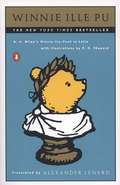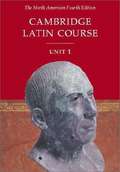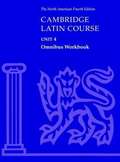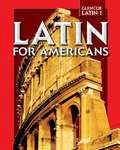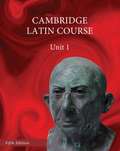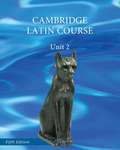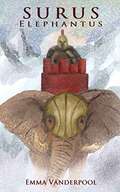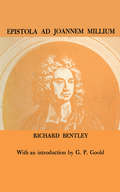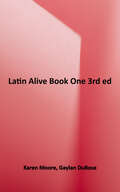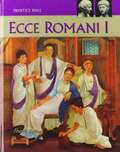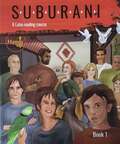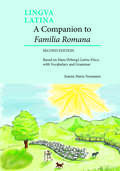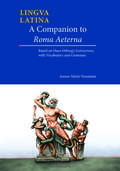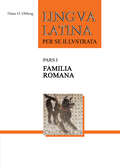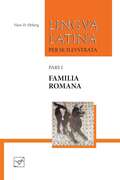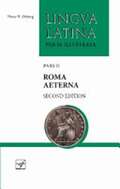- Table View
- List View
Winnie Ille Pu
by A. A. Milne Alexander Lenard"... diem cum Pu ac Porcellus heffalumpum capere conati sunt ..." "Non ceperunt, ceperuntne?" "Minime vero." Tu nequivit, quia omnis cerebri expers est. Ego autem heffalumpum cepi?" "Vere, istud pars fabulae est." Christophorus Robinus adnuit: "Egomet reminiscor," dixit. "Sed eae res fugiunt Pui memoriam, qua de causa fabulas bis narratas diligit. Tum tamen fabula vera est, non solum opus memoriae." "Equidem non secus sentio," dixi. Christophorus Robinus suspirium ab imo duxit, ursum pede apprehendit et Pum post se trahens ad ostium iit. Apud ostium se convertens dixit: "Venisne ut me in balneo videas?" "Possum," dixi. "Num eum ictu laesi?" "Minime vero." Adnuit et exiit et interposito deinde brevi tempore audivi Winnie ille Pum BUMP-BUMP-BUMP gradibus post eum ascendere.
A Song of War: Readings from Vergil's Aeneid
by Richard A. Lafleur Alexander G. MckayNIMAC-sourced textbook
Cambridge Latin Course, Unit 1
by Patricia E. Bell Stan Farrow Anne Shaw Peter Kesteven Joy Mellor Leslie Jones Stephanie M. Pope Neil Sutton Randy ThompsonThe Fourth Edition Cambridge Latin Course is an introductory program organized into four well-integrated units. Cambridge's proven approach includes a stimulating continuous story line, interwoven grammatical development and cultural information, supportive illustrations and photographs, and a complete Language Information section. Reading is the heart of the Cambridge Latin Course, and all the elements of the program - illustrations, vocabulary, grammar and syntax, cultural contexts and references, activities - are carefully introduced and arranged to provide students with the skills they need to read with comprehension and enjoyment from the very first page.
Cambridge Latin Course, Unit 4, Omnibus Workbook
by Patricia E. Bell Stan Farrow Richard M. Popeck Anne Shaw Peter Kesteven Joy Mellor Leslie Jones Stephanie M. Pope Neil SuttonThe North American Cambridge Latin Course is a well-established four-part Latin program whose approach combines a stimulating, continuous storyline with grammatical development, work on derivatives, and cultural information. There is also a complete Language Information section, plus numerous color photographs illustrating life in the Roman world. The Course has now been fully revised and updated in light of feedback from user schools, and includes the very best in new research. The Fourth Edition continues to offer teachers and students alike a stimulating, reading-based approach to the study of Latin. The Omnibus Workbook is designed to be used in conjunction with the Unit 4 Student's Text. A variety of exercises is provided for each Stage.
Vergil's Aeneid: Selected Readings From Books 1, 2, 4, And 6
by Vergil Barbara Weiden Boyd Bridget Buchholz D. Scott Van HornNIMAC-sourced textbook
Ovid: Amores, Metamorphoses Selection
by Ovid Laurie Haight Keenan Charbra Adams Jestin Phyllis B. Katz Bridget Dean Laurel DraperNIMAC-sourced textbook
Caesar: Selections From His Commentarii De Bello Gallico
by Julius Caesar Hans-Friedrich Mueller Donald E. Sprague Bridget S. DeanNIMAC-sourced textbook
Cambridge Latin Course (North American Cambridge Latin Course Ser. #Unit 1)
by Cambridge University PressNIMAC-sourced textbook
Cambridge Latin Course (North American Cambridge Latin Course Ser. #Unit 2)
by Cambridge University PressNIMAC-sourced textbook
Cicero: Pro Archia Poeta Oratio (Annotated Latin Collection)
by Cicero Steven M. Cerutti Gaby HuebnerNIMAC-sourced textbook
Surus: Fābula Bellī et Elephanti
by Emma VanderpoolSurus the Elephant is the mightest and largest elephant in the army and as such is Hannibal's favorite. The Carthaginian general has plans that will take his army, including men and elephants alike, from Africa, through Spain and Gaul, and directly into Roman territory. This novella recounts the stories of Surus the Elephant and his Mahout (elephant trainer) Mago as they recount their dangerous journey together to Italy. This book contains some 3,000 words total. Of which, there are 130 different words (excluding proper nouns). The book, with sheltered vocabulary and unsheltered grammar, is geared towards intermediate students.
Epistola ad Joannem Millium
by G. P. Goold Richard BentleyThe year 1962 marks the tercentenary of the birth of Richard Bentley (1662-1742), Master of Trinity College, Cambridge, editor of Paradise Lost, but principally and justly famous as one of the greatest classical scholars. To mark the event, the University of Toronto Press is issuing a special reprint of Alexander Dyce's edition of the Epistola (1691), the work which first brought Bentley fame, and which has long been out of print.<P><P>This Latin exercise was called forth by one of those unhappy productions which, mediocre themselves, have had the ill luck to attract the inspection of genius. In the eighth or ninth century A.D., Joannes Malelas of Antioch, a Greek writer, attempted a chronological record of mankind and in it he had recourse to name or quote from classical works no longer extant. English scholars in the seventeenth century prepared a translation of the chronicle into Latin and an accompanying commentary; just before its publication, under the final editorship of John Mill, Bentley was given an opportunity to read proof-sheets and the result was the Epistola, a collection mainly of some twenty-five notes upon statements found in or topics suggested by Malelas. <P>This extraordinary performance by a scholar of 29 moves from one topic to another over a wide range of ancient literature, explaining or correcting some sixty Greek and Latin authors. The notes are not so much a commentary on the old chronicler as a set of dazzling dissertations pegged upon a random set of appalling howlers, and they reveal prodigious information and gift of divination. Bentley's style in Latin is clear and spirited and seasoned with choice of quotation. <P>The Epistola immediately secured for its writer the fame reserved for men of the rarest excellence and this classic among academic productions is still charged with power to instruct and inspire the scholarship of another era.
Latin Alive! (Latin Alive Series #Book One)
by Karen Moore Gaylan DuBoseStudents will be delighted by what they learn in each new chapter of Latin Alive!, Book One, and they will learn to see that Latin is everywhere around them. As the first text in a three-year series, it is a rigorous and thorough introduction to this great language and is designed to engage upper school (middle and high school) student. Brimming with relevant facts and stories this text offers something for everyone. A Teacher’s Edition including answer keys, teacher’s helps and additional activities is available separately.
Suburani
by Hands Up EducationExcerpt from the back cover: "It's the spring of AD 64 and, as dawn breaks over the Subura in Rome, a young woman calls from high in an apartment building to her aunt working in a bar below. While her father collects the rent from the other tenants, a falling tile narrowly misses a senator's son passing through the streets in a litter. Was it an accident? In the Subura, your life hangs by a thread.
A Companion to Familia Romana: Based on Hans Ørberg's Latine Disco, with Vocabulary and Grammar
by Jeanne Neumann Hans H. ØrbergThis volume is the completely reset Second Edition of Jeanne Marie Neumann's A College Companion (Focus, 2008). It offers a running exposition, in English, of the Latin grammar covered in Hans H. Ørberg's Familia Romana, and includes the complete text of the Ørberg ancillaries Grammatica Latina and Latin–English Vocabulary. It also serves as a substitute for Ørberg's Latine Disco, on which it is based. As it includes no exercises, however, it is not a substitute for the Ørberg ancillary Exercitia Latina I. Though designed especially for those approaching Familia Romana at an accelerated pace, this volume will be useful to anyone seeking an explicit layout of Familia Romana's inductively-presented grammar. In addition to many revisions of the text, the Second Edition also includes new units on cultural context, tied to the narrative content of the chapter.
A Companion to Roma Aeterna: Based on Hans Ørberg's Instructions, with Vocabulary and Grammar
by Jeanne Neumann Hans H. ØrbergA sequel to her widely used A Companion to Familia Romana (now in its second edition), Jeanne Marie Neumann's A Companion to Roma Aeterna offers a running commentary, in English, of the Latin grammar covered in Hans H. Ørberg's Roma Aeterna, and includes the complete text of the Ørberg ancillaries Grammatica Latina and Latin–English Vocabulary II. It also serves as a substitute for Ørberg’s Instructions, on which it is based. Though designed especially for those approaching Roma Aeterna at an accelerated pace, this volume will be useful to anyone seeking an explicit exposition of that volume's implicitly presented grammar. In addition to many revisions of the text, A Companion to Roma Aeterna also includes new units on cultural context, tied to the narrative content of the chapter.
Familia Romana (Lingua Latina #1)
by Hans H. ØrbergHans Ørberg's Lingua Latina per se Illustrata is the world's premiere series for learning Latin via the Natural Method. The Natural Method encourages students to learn Latin without resorting to translation, but instead by teaching them to think in the language: students first learn grammar and vocabulary inductively through extended contextual reading and an ingenious system of marginal notes. Lingua Latina per se Illustrata is also the most popular series for those teachers at both the secondary and collegiate levels who wish to develop Latin conversational skills in the classroom.Familia Romana (the main book of Pars I of the Lingua Latina per se illustrata series) contains thirty-five chapters and describes the life of a Roman family in the 2nd century A.D. It culminates in readings from classical poets and Donatus's Ars Grammatica, the standard Latin school text for a millennium. Each chapter is divided into two or three lessons (lectiones) of a few pages each followed by a grammar section (Grammatica Latina) and three exercises (Pensa). Hans Ørberg's impeccable Latin, humorous stories, and the Peer Lauritzen illustrations, reproduced in full color, make this work a classic. The book also includes a table of declensions, a Roman calendar, and a word index (index vocabulorum). The Lingua Latina series incorporates the following features:The most comprehensive treatment of Latin grammar available in an elementary textbook.A vocabulary of almost 1,800 words, reinforced by constant and creatively phrased repetition, vastly expands the potential for later sight reading.A complete line of ancillary volumes, exercises, and readers both in print and online.
Familia Romana (Lingua Latina #Book One)
by Hans H. ØrbergHans Ørberg's Lingua Latina per se Illustrata is the world's premiere series for learning Latin via the Natural Method. The Natural Method encourages students to learn Latin without resorting to translation, but instead by teaching them to think in the language: students first learn grammar and vocabulary inductively through extended contextual reading and an ingenious system of marginal notes. Lingua Latina per se Illustrata is also the most popular series for those teachers at both the secondary and collegiate levels who wish to develop Latin conversational skills in the classroom. <p><p>Familia Romana (the main book of Pars I of the Lingua Latina per se illustrata series) contains thirty-five chapters and describes the life of a Roman family in the 2nd century A.D. It culminates in readings from classical poets and Donatus's Ars Grammatica, the standard Latin school text for a millennium. Each chapter is divided into two or three lessons (lectiones) of a few pages each followed by a grammar section (Grammatica Latina) and three exercises (Pensa). Hans Ørberg's impeccable Latin, humorous stories, and the Peer Lauritzen illustrations, reproduced in full color, make this work a classic. The book also includes a table of declensions, a Roman calendar, and a word index (index vocabulorum). <p><p>The Lingua Latina series incorporates the following features: <p><p>The most comprehensive treatment of Latin grammar available in an elementary textbook. <p><p>A vocabulary of almost 1,800 words, reinforced by constant and creatively phrased repetition, vastly expands the potential for later sight reading. <p><p>A complete line of ancillary volumes, exercises, and readers both in print and online.
Lingua Latina: Pars II: Roma Aeterna
by Hans Ørberg"Roma Aeterna (the main book of Pars II of the Lingua Latina per se illustrata series) introduces some of the most celebrated authors of Roman antiquity through the lens of Roman literature and mythology. A vivid description of the city's monuments precedes a prose retelling of the first four books of Virgil's Aeneid, with many of the most famous passages in their original verse form. The selection from Virgil is followed by Book One of Livy's engaging mythical history of Rome's foundation. The prose selections are judiciously chosen and, in the first few chapters, gently adapted to provide students with a text that is authentically Latin and yet not difficult. The unadapted selections, which make up the majority of the text, are taken from Aulus Gellius, Ovid, Nepos, Sallust, and Horace. These annotated selections make Roma Aeterna useful both as the next step after Familia Romana and as a survey of Latin literature in its own right."--Publisher's description.
